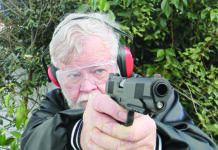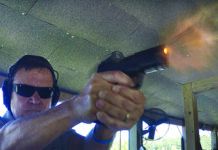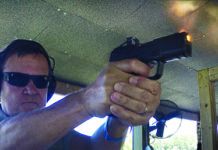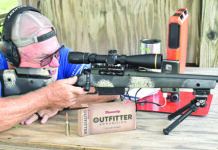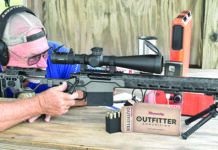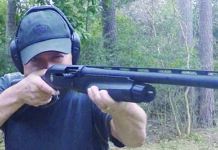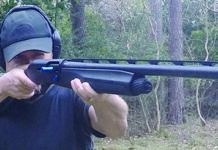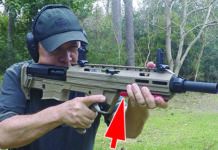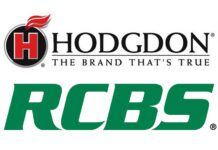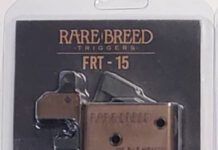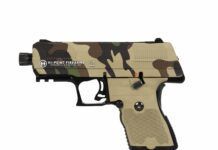Some of us who know that theres no substitution for bullet mass when it comes to stopping power prefer the 45 Auto for self defense. But no one likes to pack a heavy handgun, so most makers offer some solutions to that problem in the form of lighter-weight 1911s. These generally utilize aluminum frames, with shorter grips and slides. Any 45 Auto requires good management by the shooter, so these lighter and shorter-grip guns are not for everyone. One of the better 45 compromises is the use of a full-size aluminum grip frame combined with a short slide. Colt calls this setup the Lightweight Commander. In this test comparison one of the guns had a configuration that was similar to Colts LW Commander, but lacked a barrel bushing. The shorter “Officers Model” grip, to use another old Colt name, is undoubtedly easier to conceal, and two of the guns in this test use that setup. Modern magazines for the shorter “Officers” grip hold seven rounds, so they dont give up capacity when compared to the original 1911 design, but of course most full-size 1911s today hold eight in the mag.
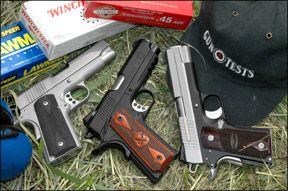
In February 2009 we compared the Sig Sauer 1911 C3 to the discontinued Colt CCO (and Kahr PM 4543), and noted that there are not a whole lot of options if you must have the Officers frame with the Commander-length slide, which is the CCOs setup. But we found a handgun by Kimber that is mighty close to that concept, and decided to also look at one of the full-grip, light-frame, short-slide offerings by Springfield to see how they both stacked up to the Sig Sauer 1911 C3 No. 19GS0031 (MSRP $1200; street price about $975). The two new guns were Kimbers Compact Stainless II (MSRP $1009; street price about $850) and the Springfield Armory Champion Operator PX9115LP (MSRP $1076; street price about $850). Heres what we found.
Kimber Compact Stainless II 45 ACP,
(MSRP $1009, Street Price about $850)
The finish on the Kimber was all matte stainless except for the fixed sights, which were matte blued, and the grips, which were black checkered rubber. The slide was marked with the guns designation on the right and the Kimber logo on the left. The extended left-side safety was easy to use, and we liked the look and feel of the black rubber grips. The rear mainspring housing was checkered, and although it was made of plastic like that on the Colt CCO, we had no problems with the method or material of construction, having had years of experience with the Colt setup. It works, and is lighter than steel. The Kimber did not have checkering on its front strap. In fact, only the Sig had that feature. One magazine came with the gun, but we also got two extras ($30 each) with slam pads. The slam pads make it easier to speed-load guns with the shorter grips. We noted the magazines for the Sig are identical to those for the Kimber, i.e., made by the same company, and theyll both fit the Colt CCO.
The fit and finish were excellent on the Kimber. One fault was the sharp edge all around the ejection port, which could cut hands in clearance drills. The Springfield also had some knife edges on the port, but the good folks at Sig have realized knife edges belong on knives, not handguns. The Kimbers sight picture was pretty good, as it was on all three guns, but we thought the Kimber could use a bit more light on the side of the front blade for faster work. Both front and rear sights were dovetailed into the slide. The rear had an Allen screw to lock it. The front relied on friction.
This gun (and also the Springfield) had no front barrel bushing. The barrel gets fatter at the front to fill the hole in the slide. Beneath the barrel is the rod-like keeper for the recoil spring, and you need a suitable tool to remove it. Kimber provides two of them. To
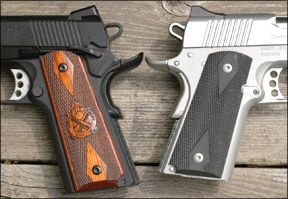
get the gun apart you clear it, rack it open, insert the bent-wire tool, slowly release the slide, pop out the slide-stop pin and take the slide off the frame. Then the parts come out easily, spring to the rear and barrel to the front. The spring assembly can be taken apart for cleaning, using lots of care and always wearing safety glasses.
The end result of such a design is that you have fewer parts to the gun, which makes maintenance less of a chore. From what weve seen, the performance is not affected in a negative way either, by the elimination of the original-design spring and plunger and front bushing. However, traditionalists, die-hards, and older gun writers will always prefer the original 1911 system, which the Sig has, so you can take the gun apart entirely by hand, with no tools needed. Will you have that takedown tool with you in the field?
Inside the gun we found excellent workmanship, with one questionable area that well watch in our follow-up shooting sessions. The feed ramp was slightly pitted or rough. We had test fired the gun before disassembly, and it appeared as if the bullet noses had slightly battered the aluminum of the ramp. This was not an issue on the Springfield, which had a steel extension from the barrel that formed its ramp. The Colt and the Sig both had aluminum ramps, but neither showed any battering. We would watch this area carefully if we owned this gun.
At the range we had no problems with the Kimber. We tested with Black Hills 230-grain JHP, Lawman 230-grain ball, and with Winchester 185-grain BEB ammunition, and they all fed and fired and ejected with zero problems. The accuracy was way more than adequate, with smallest five-shot group from the Winchester BEB ammo, which measured 0.9 inch. We had another fine four-shot cluster with the Lawman ammo of just 0.6 inch, but one of the five made it a 1.3-incher.
Rapid fire presented no major problems either, but again we noticed the lack of white space on the sides of the front-sight blade. The rubber grips seemed to aid in recoil handling. We would have liked to have either night sights or a white dot on the front sight to help us see the sight picture faster in questionable light. Red or white nail polish is one quick way to accomplish that. The clean trigger broke at just over 4.5 pounds.
Our Team Said: We like the feel and balance of the Kimber. It shot exactly to its sights with our test ammo. We could not fault it in our short test time. It always worked, shot well, and looked great, we thought. While we would have liked night sights and front-strap checkering, these are not all that necessary and would add lots to the overall cost. We though the Kimbers price tag was reasonable. Finding a good holster would not be a problem here either.
Springfield Armory Lightweight Champion
Operator No. PX9115LP 45 ACP, MSRP $1076
(Street price about $850)
Matte blue finish that looked like Parkerizing (“Armory Kote”), contrasting with reddish-brown
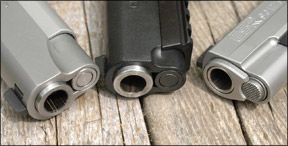
cocobolo checkered grips characterized the Springfield Champion Operator. It looked efficient. This short 45 had night sights and a rail to accommodate a tactical light under its nose, never mind that if youre using a search light, you wont see the night sights. The black-anodized frame had a full-length grip, which tended to give a more secure grasp on the gun. The checkered mainspring housing was steel, but there was no sticky stuff on the front strap. Also, the good-looking wood grips were on the slippery side despite the nice checkering. The fixed sights were dovetailed in place, with a security roll pin on the front unit and an Allen screw on the rear.
The gun was fitted with an ambidextrous safety, which we did not like because it bumped our strong-hand knuckle, both for righties and lefties. We also found the safety very difficult to put on with the shooting-hand thumb. This did not get any better during our test sessions, and would have to be fixed before we could call this gun street ready.
The ejection port edges were not quite as sharp as those on the Kimber, but still a bit too sharp, we thought. You can either live with that, or do some quick work with a file to get rid of the offensive edges. But that will destroy the Springfields finish at those areas. Two seven-round magazines came with the gun, and the hard case also held a large cleaning brush, a plastic holster and a two-unit magazine holder. These latter additions came with instructions, which was good, because if you simply jam the gun into the holster you may have trouble getting it back out, until youve performed the necessary adjustments to the holster. Yes, thats the voice of experience. Also, because of the integral light rail under the gun, Springfield has taken the toil out of finding a suitable holster. By the way, the holster will not accommodate the gun with a light mounted.
We found all the controls on this gun, except the trigger, to be very stiff. The spring forces on the hammer and slide-return spring were greater than those for the Kimber or Sig. This was about the only distraction from an otherwise excellent pistol. The trigger broke cleanly at 4.7 pounds.
Now, then, the takedown procedure…. We have never encountered a worse setup in our experience than what is provided by Springfield to disassemble this handgun. You need Springfields small dedicated plastic collar that snaps onto the slide-spring retaining rod, but theres no room to get your fingers in there to snap it into place. So you need not only the plastic collar, but also a small screwdriver or other tool to be able to position that collar and press it home. Then, with the spring and its rod bound up by the plastic piece, you remove the cross pin and off comes the slide. The captured spring and the barrel come out like on the Kimber. That revealed the excellent workmanship inside, which was small reward for the contortions needed to get in there. An alternate takedown method still utilized the plastic block to get the gun apart. Imagine a soldier in a sandy battleground, full battle gear on his back, with the sudden need to get his gun apart quickly. Hes poking through his pockets trying to find that little piece of plastic, and if hes lucky enough to find it, we suspect he wont be able to snap it gently to the recoil rod. We suspect that plastic piece and this gun would quickly be buried in the sandy soil of that battleground, and a suitable replacement found.
Putting the gun back together was just as bad. The plastic piece caught on the slide opening just enough to require lots of force to get it through the hole. Then the slide-lock pin would not cam the spring plunger out of the way when we tried to get the slide lock back into the gun. We had to use a small screwdriver to depress the plunger, press the slide-stop pin into place, and then fight with the plastic piece to try to get it off the rod and out of the way so the gun could close. We didnt think much of that system.
At the range the Lightweight Champion Operator shot about on a par with the Kimber and Sig. The average
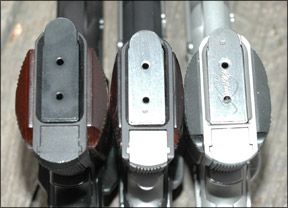
of all five-shot groups was 1.8 inches, the best being 1.2 inches and the worst being 2.5, both with Lawman 230-grain ball. The gun showed a tendency to shoot smaller groups the more we shot it, so wed guess you could count on better-than-1.5-inch clusters at 15 yards, depending on the shooter and the ammo selection. For some folks the night sights, the full-size grip, and the ambi safeties would be the deciding factors. We personally didnt care for the bulk and related bulky feel of the under-carriage rail, but if you want a light on your gun, this is a great way to put it there.
Rapid fire with the Lightweight Champion Operator was easy. The good trigger and full-size grip made fast shooting not much of an issue, though this gun is still lighter than a full-size 1911, so it bucks a bit. But we found we could do very good work with it in fast shooting. The night sights looked like white dots in the daylight, and helped us get on target quickly.
Our hats are off to Springfield for leaving off the firing-pin safety lock and for the integral and very beefy ramp on the back end of the barrel. Also, the smoothly tapered barrel gave us confidence in their machinists. We would have liked to see more of the chamber mouth beveled to aid off-center feeding, but in truth, the gun always worked, so maybe its beveled enough. But we deplore the takedown procedure, and encourage Springfield to change it. The Kimber required a takedown tool, but if you lost it you could make one in 10 seconds from a paper clip. We suspect the Champions takedown procedure will keep some buyers away from this otherwise excellent gun.
Our Team Said: We thought the gun was a bit rough, and needed some smoothing on its controls, especially the safety. Part of the roughness would go away with continued use, but much of it would remain. The spring forces on the hammer and slide wont diminish, so youll be fighting them forever. Sharp edges along the bottom of the slide can be removed, as can the ejection-port edges, or they can be left alone if youre not as fussy as some of us. The accuracy and function were all excellent, and we liked the night sights and the included holster and mag pouch, but the takedown left us absolutely cold.
Sig Sauer 1911 C3 No. 19GS0031 45 ACP, $1200
(Street price about $975)
The Sig C3 got a grade of A in our previous test when compared with a Colt CCO, and nothing we found in this comparison changed that. However, we thought the Kimber Compact Stainless II would be a reasonable alternative, because its $200 less expensive at full list, and performs about as well as the Sig. But in light of the C3s wonderfully thin wood grips, easy no-tools takedown, checkering on the front grip strap, fine fitting, night sights, and equal accuracy, for not much more money, wed go with the Sig. Since we first tested it 18 months ago its price has gone up from $1143 to $1200. Sig Sauer has a full line of 1911-type auto pistols in several calibers, well worth a hard look (www.sigsauer.com) before you spend any money. There is a variation of the C3 with increased dehorning, for about $100 more, and you have a choice of two finishes, either like ours or with black “Nitron.”
For your money you get a good-looking, accurate, concealable 45 auto with night sights, checkered-steel mainspring housing, perfectly done 25-line-per-inch checkering on the front grip strap, a stainless slide and barrel, and well-done matte-black finish on the grip frame. You also get outstanding workmanship and great reliability. Those thin wood grips give the gun a unique feel that makes it seem smaller than it is, and make it point better too. The sights are fixed and dovetailed, the rear secured with an Allen screw, and the front with a roll pin. The safety is on one side only. The top of the slide is somewhat flattened out in contour, which might make it interfere with some holsters. Sig Sauer sells holsters from the company website.
Our Team Said: We shot the C3 against the other two handguns and it had about the same accuracy as they did. There were no surprises, and the Sig worked perfectly for us. We still rate it an A, and would pick it over the other two guns despite the slightly greater cost.
0810-SHORT-45-ACCURACY-CHRONO.pdf



